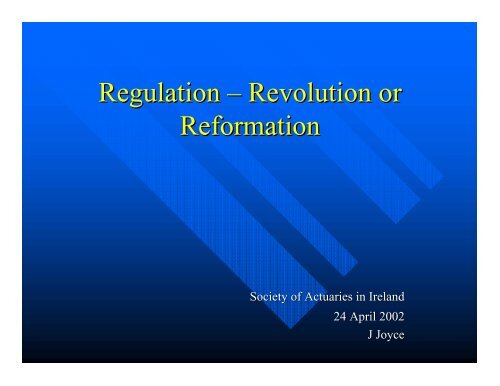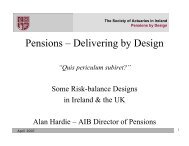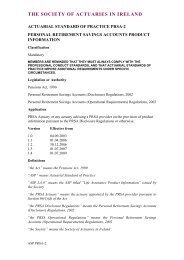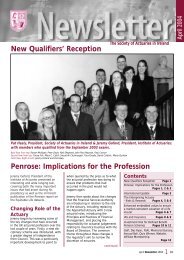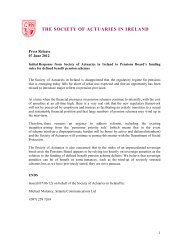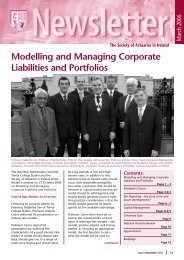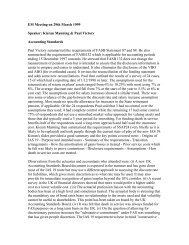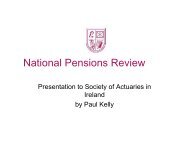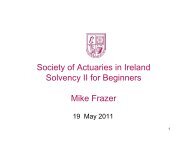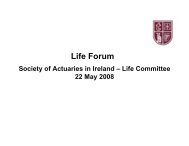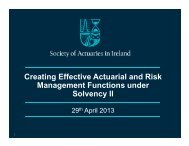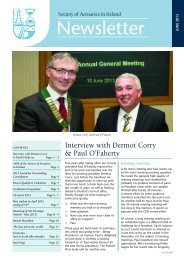Jimmy Joyce - Society of Actuaries in Ireland
Jimmy Joyce - Society of Actuaries in Ireland
Jimmy Joyce - Society of Actuaries in Ireland
Create successful ePaper yourself
Turn your PDF publications into a flip-book with our unique Google optimized e-Paper software.
Regulation – Revolution or<br />
Reformation<br />
<strong>Society</strong> <strong>of</strong> <strong>Actuaries</strong> <strong>in</strong> <strong>Ireland</strong><br />
24 April 2002<br />
J <strong>Joyce</strong>
The Chang<strong>in</strong>g Regulatory Scene<br />
<strong>in</strong> Life Assurance<br />
• National<br />
Unified Supervision <strong>of</strong> F<strong>in</strong>ancial Services<br />
• EU ) F<strong>in</strong>ancial Report<strong>in</strong>g<br />
• International ) Solvency Supervision<br />
• Impact on Life Assurance Regulation
Central Bank and F<strong>in</strong>ancial Services<br />
Authority Bill 2002<br />
• McDowell Report<br />
• <strong>Society</strong> <strong>of</strong> <strong>Actuaries</strong>’ Views<br />
• Monetary Functions / F<strong>in</strong>ancial Services Supervision<br />
• Prudential / Market Supervision
Irish F<strong>in</strong>ancial Services Regulatory<br />
Authority<br />
• Structure<br />
• Unified Supervision <strong>of</strong> F<strong>in</strong>ancial Services<br />
• Bank<strong>in</strong>g and Insurance – Contrast<br />
• Regulatory Style – Bus<strong>in</strong>ess Based or Risk Based<br />
• Lessons from British F<strong>in</strong>ancial Services Authority<br />
• Implications for Life Assurance Supervision
Present Basis <strong>of</strong> Life Assurance Regulation<br />
• F<strong>in</strong>ancial Report<strong>in</strong>g<br />
• Solvency Supervision<br />
• Modified Statutory<br />
• Deferral and Match<strong>in</strong>g<br />
• Income and Expenditure based<br />
• EU Life Directives<br />
• Market Value <strong>of</strong> Assets<br />
• Diversification & Admissibility<br />
Rules<br />
• Prudent Valuation <strong>of</strong> Liabilities<br />
• Prudential Marg<strong>in</strong>s<br />
• Solvency Marg<strong>in</strong>s<br />
Pr<strong>of</strong>essional Input<br />
Auditor<br />
Appo<strong>in</strong>ted Actuary<br />
Why Change
Why Change <br />
• F<strong>in</strong>ancial Report<strong>in</strong>g<br />
Understandable / relevant/ reliable<br />
Comparable across<br />
– time<br />
– companies<br />
– <strong>in</strong>stitutions<br />
Is Insurance Special <br />
To Reflect Reality<br />
- Market Based<br />
- Balance Sheet Based<br />
• Solvency Supervision<br />
To Reflect Reality<br />
- Based on F<strong>in</strong>ancial Reports<br />
- Transparent Capital Adequacy<br />
- Risk Based Capital<br />
Consequences<br />
- Pr<strong>of</strong>it<br />
- Volatility
F<strong>in</strong>ancial Report<strong>in</strong>g<br />
• All listed EU Companies to use International F<strong>in</strong>ancial<br />
Report<strong>in</strong>g Standards (IFRS) by 2005<br />
– <strong>in</strong>clud<strong>in</strong>g <strong>in</strong>surers and banks<br />
– EU regulations by end 2002<br />
– International Account<strong>in</strong>g Standards Board (IASB)<br />
project on Insurance Account<strong>in</strong>g<br />
Draft statement <strong>of</strong> Pr<strong>in</strong>ciples 2001<br />
Exposure Draft 2002 <br />
F<strong>in</strong>al Draft 2003 <br />
Implementation 2005
Fair Value<br />
Fair Value is the amount for which an asset could be<br />
exchanged or a liability settled between knowledgeable,<br />
will<strong>in</strong>g parties <strong>in</strong> an arms length transaction.<br />
Why Fair Value <br />
Account<strong>in</strong>g rather than actuarial<br />
Account<strong>in</strong>g Pr<strong>in</strong>ciples - understandability, relevance,<br />
reliability,comparability.<br />
Actuarial Pr<strong>in</strong>ciples - asset/liability approach<br />
- market based assessment
Issues for Long Term Insurance<br />
– Def<strong>in</strong>ition <strong>of</strong> <strong>in</strong>surance contract<br />
– Optionality <strong>in</strong> benefits<br />
– Dependence <strong>of</strong> benefits on assets held<br />
– Allowance for future premiums<br />
– Practical issues (market <strong>in</strong>formation, calculation)
Insurance IAS – Will it happen <br />
• Exposure Draft still <strong>in</strong>complete<br />
– IASB March meet<strong>in</strong>g did not reach even a tentative<br />
conclusion on deferral / match<strong>in</strong>g versus asset / liability<br />
for “performance report<strong>in</strong>g” <strong>of</strong> <strong>in</strong>surance contracts
Insurance IAS – Will it happen …<br />
• Letter from US, German and Japanese life assurance trade<br />
bodies to IASB<br />
– Approach elim<strong>in</strong>ates ability <strong>of</strong> management and stakeholders to<br />
focus on operat<strong>in</strong>g results<br />
– Approach will produce mislead<strong>in</strong>g and deceptively volatile results,<br />
s,<br />
not related to underly<strong>in</strong>g economics or future cashflow<br />
– Volatility could cause policyholders to take actions not <strong>in</strong> their r best<br />
<strong>in</strong>terest<br />
– Stockholders will make <strong>in</strong>appropriate judgements on the real<br />
stability <strong>of</strong> <strong>in</strong>surers<br />
Parallels with FRS 17
F<strong>in</strong>ancial Report<strong>in</strong>g Questions<br />
• EU decision for 2005<br />
– Can deadl<strong>in</strong>e be met for <strong>in</strong>surance companies <br />
– If not, can Insurance Accounts Directive cont<strong>in</strong>ue to<br />
apply<br />
• Read<strong>in</strong>ess for Fair Value Report<strong>in</strong>g<br />
– Listed <strong>in</strong>surers<br />
– More general application
Prudential Supervision<br />
Changes <strong>in</strong> Course <strong>of</strong> Implementation<br />
• Solvency 1 Exercise<br />
• EU Directive <strong>of</strong> March 2002<br />
– M<strong>in</strong>imum Harmonisation<br />
– Early Intervention<br />
– Indexation <strong>of</strong> M<strong>in</strong>imum Guaranteed Fund<br />
– Items eligible for Solvency Marg<strong>in</strong><br />
– Unit L<strong>in</strong>ked Bus<strong>in</strong>ess<br />
– Permanent Health Insurance<br />
– Re<strong>in</strong>surance<br />
– Deteriorat<strong>in</strong>g F<strong>in</strong>ancial Position
Solvency I<br />
Solvency II<br />
Why Solvency II <br />
• Criticisms <strong>of</strong> Current Approach<br />
– Lack <strong>of</strong> transparency<br />
– Narrow scope <strong>of</strong> risks considered<br />
– Insensitivity to company specific risk pr<strong>of</strong>iles<br />
– Need for convergence <strong>of</strong> prudential rules across sectors<br />
– Integration with f<strong>in</strong>ancial report<strong>in</strong>g<br />
• Parallel Work at <strong>in</strong>ternational level<br />
– International Association <strong>of</strong> Insurance Supervisors<br />
– International Actuarial Association
Solvency II Process (1)<br />
• Initiated by EU Commission / Insurance Committee.<br />
• Solvency II Work<strong>in</strong>g Group<br />
– Formation <strong>of</strong> specialist groups<br />
– Consultancy Study (methodologies to assess the overall f<strong>in</strong>ancial<br />
position <strong>of</strong> an <strong>in</strong>surance undertak<strong>in</strong>g from the perspective <strong>of</strong><br />
prudential supervision)<br />
– Review <strong>of</strong> the prudential system <strong>in</strong> Bank<strong>in</strong>g (New Basle Accord)<br />
– Review <strong>of</strong> Risk Based Capital systems<br />
– Consideration <strong>of</strong> Prudential Regimes <strong>in</strong> EU<br />
– Template for new EU systems by end 2002
Solvency II Process (2)<br />
• Specialist Groups<br />
– Restricted Work<strong>in</strong>g Groups on Technical Reserves<br />
– Conference <strong>of</strong> Insurance Supervisors Group<br />
» Risk <strong>in</strong>terrelationship analysis<br />
» Regulatory breaches<br />
» “Near misses” analysis<br />
» Case studies<br />
» Diagnostic / preventative / curative tools<br />
» Prelim<strong>in</strong>ary conclusions
New Basle Accord<br />
• Three Pillar Approach<br />
– M<strong>in</strong>imum capital requirement<br />
– Supervisory review process<br />
– Measures to foster market discipl<strong>in</strong>e<br />
• M<strong>in</strong>imum Capital Requirements<br />
– Credit risk<br />
– Market risk<br />
– Operational risk<br />
• Determ<strong>in</strong>ation <strong>of</strong> Capital Requirements<br />
– Standardised approach<br />
– Internal models
IAA Pr<strong>in</strong>ciples for Prudential Regulation<br />
• Prudential report<strong>in</strong>g requires marg<strong>in</strong>s <strong>in</strong> excess <strong>of</strong> those <strong>in</strong><br />
general purpose accounts<br />
• Excess marg<strong>in</strong>s should be transparent<br />
• Capital requirements should relate to risks not to provider<br />
(bank, <strong>in</strong>surer etc)<br />
• Prudential supervision should encourage / reward good<br />
risk management<br />
• Capital requirement should take account <strong>of</strong> assets held and<br />
policy options<br />
• There should be trigger po<strong>in</strong>ts to act as warn<strong>in</strong>g signs
Future Prudential Report<strong>in</strong>g<br />
General purpose<br />
Regulatory accounts<br />
Free Assets<br />
Shareholder Equity<br />
Prudential<br />
Marg<strong>in</strong>s (risk<br />
based capital)<br />
GAAP Marg<strong>in</strong>s<br />
Required Regulatory Assets<br />
Fair Value Liability<br />
Best Estimate<br />
Liability
F<strong>in</strong>al Thoughts<br />
• Timescale<br />
• Policy for Irish Regulator <br />
• Implications for Irish Regulator <br />
• Revolution or Reformation


